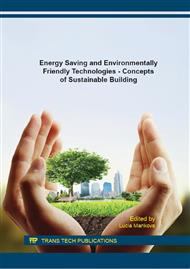[1]
M. Halahyja, Nové tepelnotechnické problémy pozemných stavieb (New thermal problems of civil engineering), first ed., Slovak Academy of Sciences, Bratislava, 1967 (in Slovak).
Google Scholar
[2]
J. Řehánek, Tepelná akumulace budov (Heat accumulation of buildings), first ed., ČKAIT (CZECH CHAMBER certified engineers and technicians active in construction), Praha, 2002. (in Czech).
Google Scholar
[3]
Katunský, D., & Lopušniak, M. Impact of shading structure on energy demand and on risk of summer overheating in a low energy building. Energy Procedia, 14, 2012, p.1311–1316.
DOI: 10.1016/j.egypro.2011.12.1094
Google Scholar
[4]
Anna Mavrogianni, Paul Wilkinson, Michael Davies, Phillip Biddulph, Eleni Oikonomou, Building characteristics as determinants of propensity to high indoor summer temperatures in London dwellings, Building and Environment, Volume 55, September 2012, Pages 117-130.
DOI: 10.1016/j.buildenv.2011.12.003
Google Scholar
[5]
Ozoliņš, A., Jakovičs, A. & Gendelis, S. Impact of Different Building Materials on Summer Comfort in Low-Energy Buildings. Latvian Journal of Physics and Technical Sciences, 52(3), 2015, pp.44-57.
DOI: 10.1515/lpts-2015-0017
Google Scholar
[6]
ČSN 730540-4 Tepelná ochrana budov - Část 4: Výpočtové metody (Thermal protection of buildings – part 4: Calulation methods), Úřad pro technickou normalizaci, metrologii a státní zkušebnictví, Praha, 2005. (in Czech).
Google Scholar
[7]
ISO 13792: 2012 Thermal performance of buildings - Calculation of internal temperatures of a room in summer without mechanical cooling - Simplified methods, Úřad pro technickou normalizaci, metrologii a státní zkušebnictví, Praha, (2012).
DOI: 10.3403/30202120
Google Scholar
[8]
M. G. Davies, Building Heat Transfer, John Wiley and Sons Ltd, Chichester, (2004).
Google Scholar
[9]
ISO 13786: 2007 Thermal performance of building components - Dynamic thermal characteristics - Calculation methods, Úřad pro technickou normalizaci, metrologii a státní zkušebnictví, Praha, (2008).
Google Scholar
[10]
H. Hugo, Buillding Phisics, Ernst & Sohn Verlag für Architektur und techniche Wissenschaften GmbH und Co. KG, Berlin, (2007).
Google Scholar
[11]
H. S. Carslaw and J. C. Jaeger, Conduction of Heat in Solids, Oxford University Press, London, (1959).
Google Scholar
[12]
ISO 13791 Thermal performance of buildings - Calculation of internal temperatures of a room in summer without mechanical cooling - General criteria and validation procedures, Úřad pro technickou normalizaci, metrologii a státní zkušebnictví, Praha, (2012).
DOI: 10.3403/30114649
Google Scholar


